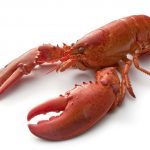 Until the eighteenth century when Swedish scientist Carolus Linnaeus established the modern system of classifying animals, philosophers and scientists used a zoological system devised in the fourth century B.C. by Aristotle, who began by dividing animals into those with red blood and those with not-red blood. This rough and ready approach to classification explains why the ancient Romans had no compunctions about giving the locust and the lobster the same name: locusta. It did not matter to the Romans that locusts live on land and lobsters in the sea, nor did it matter that lobsters weigh hundreds of times more than locusts—as far as they were concerned, the shape and greenish blood of the two creatures made them similar enough to share a single name. In English, the Latin locusta has given rise to both the word locust and the word lobster. The older of these two words is lobster, which appeared in the tenth century as the Old English lopystre; this odd spelling may have arisen as people conflated locusta (the Latin name of the ten-legged shellfish) with loppe (the Old English name of the eight-legged spider), and ended up with lopystre. By the fifteenth century, further changes in spelling and pronunciation led to the current form of the word, lobster. In contrast, locust has undergone very few changes in form and pronunciation: when the word was adopted in the thirteenth century, the a was dropped from the original Latin locusta and the word has remained unchanged ever since.
Until the eighteenth century when Swedish scientist Carolus Linnaeus established the modern system of classifying animals, philosophers and scientists used a zoological system devised in the fourth century B.C. by Aristotle, who began by dividing animals into those with red blood and those with not-red blood. This rough and ready approach to classification explains why the ancient Romans had no compunctions about giving the locust and the lobster the same name: locusta. It did not matter to the Romans that locusts live on land and lobsters in the sea, nor did it matter that lobsters weigh hundreds of times more than locusts—as far as they were concerned, the shape and greenish blood of the two creatures made them similar enough to share a single name. In English, the Latin locusta has given rise to both the word locust and the word lobster. The older of these two words is lobster, which appeared in the tenth century as the Old English lopystre; this odd spelling may have arisen as people conflated locusta (the Latin name of the ten-legged shellfish) with loppe (the Old English name of the eight-legged spider), and ended up with lopystre. By the fifteenth century, further changes in spelling and pronunciation led to the current form of the word, lobster. In contrast, locust has undergone very few changes in form and pronunciation: when the word was adopted in the thirteenth century, the a was dropped from the original Latin locusta and the word has remained unchanged ever since.
An elongated crustacean, featuring ten diminutive articulated limbs and two massive chelae, indigenous to frigid northern waters surrounding Maine and Nova Scotia. The flesh can be procured in frozen or canned form, whereas intact fresh lobsters are available pre-boiled. Nearly all lobster-based dishes, except for grilled or baked live lobster, which is dispatched just before cooking, involve boiled live lobsters submerged into boiling water, resulting in the distinctive vivid pink shell coloration. In the context of lobster, two principles should be followed: never purchase a deceased specimen, and the more sizeable the lobster, the higher the likelihood of its toughness.
An inhabitant of saltwater habitats spanning the globe, this captivating crustacean holds a special place of distinction. Valued for its succulent and luscious flesh, it remains a culinary treasure. The American lobster, scientifically known as Homarus americanus, boasts a larger size compared to its European counterpart. However, it is the frigid northern waters of the Atlantic, along the shores of Maine and Nova Scotia, that yield the most exceptional specimens. Adorned with a natural hue of mottled greenish-black, this remarkable creature undergoes a captivating transformation when subjected to the heat of cooking. Its shell transitions into a vibrant shade of bright red-orange, signaling its readiness to be savored and relished.
